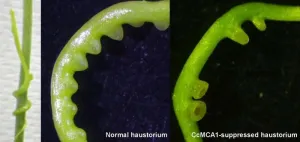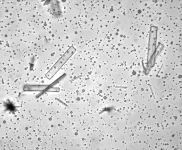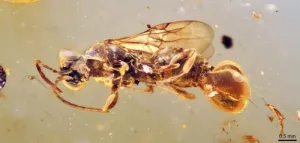(Press-News.org) University of Leeds news
Embargoed until 10:00 GMT, 27 March
Damaging cluster of UK winter storms driven by swirling polar vortex miles above Earth
Powerful winter storms which led to deaths and power outages in the UK and Ireland were made more likely by an intense swirling vortex of winds miles above the Arctic, say scientists.
A team of researchers led by the University of Leeds has pinpointed a new reason for winter storm clusters such as the trio named Dudley, Eunice and Franklin, which hit the nation within the space of a week in February 2022.
The findings which are published today in the journal Communications Earth and Environment reveal the cluster of extreme UK winter storms was connected to stronger winds in the Arctic stratosphere, and the researchers believe this could help weather forecasters to know when there is an increased risk of storm clusters up to a month before they happen.
Lead author Dr Ryan Williams, who carried out the research while at the University of Leeds, said: “Our research demonstrates the need to better understand the different drivers of the North Atlantic storm track, such as the state of the stratospheric polar vortex that is potentially predictable several weeks in advance.
“Being able to provide early warnings of possible severe weather is all the more pertinent with climate change, as there is evidence that major winter storms will become more intense, exacerbating impacts such as flooding and wind damage."
February 2022 was a particularly stormy month in the UK, Ireland, Scandinavia and Germany with several intense cyclones - rotating low pressure weather systems that often create strong winds and heavy rain.
For the first time since 2015 when the UK Met Office began naming impactful cyclones, the UK experienced three named storms in a week - Dudley, Eunice and Franklin. A total of seven storms were tracked near the UK during that month, the fourth highest number during February since 1979.
Four deaths were reported across the UK and Ireland and 1 million homes were affected by power outages lasting up to several days. The estimated insurance bill in the UK and the rest of Europe due to the windstorms was almost four billion euros.
Storm Eunice, which impacted the UK on 18th February 2022, was described as a once in a decade event and the most severe since 2014 with record wind gusts for England of 122 miles per hour recorded at the Needles on the Isle of Wight.
February 2022 was also characterised by an extremely strong stratospheric polar vortex - a large spinning mass of cold air in the stratosphere around 15 miles above the Arctic that is prominent during winter months.
The researchers were keen to understand the role played by such a strong stratospheric polar vortex (SPV) in driving the risk of the storms, something which had not previously been well explored.
They compared seasonal forecasts from January 2022, which showed the unusually strong state of the polar vortex, with those which suggested it would be close to average strength. Examining the properties of UK storms in these contrasting forecasts allowed the influence of the SPV to be identified.
They concluded that the strong SPV made it up to three times more likely there would be intense storms affecting the UK and northern Europe during February 2022.
Their results also reveal that the strong SPV at that time increased the likelihood of three or more storms reaching the UK in a single week by around 80% compared with when the SPV is normal.
Crucially, the researchers say that the signal for a strong SPV was evident from forecasts carried out as early as November 2021 and that spotting these conditions could offer a ‘window of opportunity’ for enhanced European predictability.
Co-author Jeff Knight, the Science Lead in Monthly to Decadal Prediction in the UK Met Office, said: “It’s been understood for a while that the Arctic stratosphere can affect the type of winter we get in the UK, but these results show that it can even affect the occurrence of stormy spells within the season.
“An intense stratospheric polar vortex can now be recognised as a warning to forecasters of increased risks of damaging storms. This was likely seen in the most recent winter, around the time of storm Eowyn in late January.”
Professor Amanda Maycock from the School of Earth and Environment who led the project, added: “The stormy conditions and strong stratospheric polar vortex during February 2022 bare parallels to other periods, such as what occurred in February 2020 and even what we have seen at the start of this year. Future work should investigate the connection we have found for other winters.”
Ends
For media enquiries, please contact Kersti Mitchell in the University of Leeds press office via k.mitchell@leeds.co.uk
University of Leeds
The University of Leeds is one of the largest higher education institutions in the UK, with more than 40,000 students from about 140 different countries. We are renowned globally for the quality of our teaching and research.
We are a values-driven university, and we harness our expertise in research and education to help shape a better future for humanity, working through collaboration to tackle inequalities, achieve societal impact and drive change.
The University is a member of the Russell Group of research-intensive universities, and is a major partner in the Alan Turing, Rosalind Franklin and Royce Institutes www.leeds.ac.uk
Follow University of Leeds or tag us in to coverage: Bluesky | Facebook | LinkedIn | Instagram
END
Damaging cluster of UK winter storms driven by swirling polar vortex miles above Earth
Powerful winter storms which led to deaths and power outages in the UK and Ireland were made more likely by an intense swirling vortex of winds miles above the Arctic, say scientists.
2025-03-27
ELSE PRESS RELEASES FROM THIS DATE:
Losing forest carbon stocks could put climate goals out of reach
2025-03-27
In the past, intact forests absorbed 7.8 billion tonnes of CO₂ annually – about a fifth of all human emissions – but their carbon storage is increasingly at risk from climate change and human activities such as deforestation. A new study from the Potsdam Institute for Climate Impact Research (PIK) shows that failing to account for the potentially decreasing ability of forests to absorb CO₂ could make reaching the Paris agreement targets significantly harder, if not impossible, and much more costly.
“Delaying action leads to disproportionately higher costs,” explains Michael Windisch, ...
From weight to wellness: New database transforms obesity research
2025-03-27
A new medical database automatically compiles the medical records of obese patients and those suffering from obesity-related diseases in a uniquely comprehensive and reliable manner. The initiative, led by Kobe University, offers valuable insights for health promotion and drug development.
“Obesity is at the root of many diseases,” says OGAWA Wataru, an endocrinologist at Kobe University. Obesity has been linked to the development of diabetes, hypertension, gout, coronary heart disease, stroke and many other diseases. Monitoring, treating and preventing obesity and the diseases it can cause is therefore not only good for ...
Nature’s viny vampire: Discovering what drives parasitic Cuscuta campestris
2025-03-27
The parasitic vine Cuscuta campestris grows by latching onto the stems and leaves of plants and inserting organs called haustorium into the host plant tissues to draw nutrients. The haustorium is formed when ion channels in the cell membrane are stimulated during coiling and induce a reaction within the cell.
Further, Cuscuta campestris has many types of ion channels, but which ones were linked to the development of haustorium were previously unknown.
“For the first time, the genes involved in sensing ...
How calcium may have unlocked the origins of life’s molecular asymmetry
2025-03-27
A new study led by researchers at the Earth-Life Science Institute (ELSI) at Institute of Science Tokyo has uncovered a surprising role for calcium in shaping life’s earliest molecular structures. Their findings suggest that calcium ions can selectively influence how primitive polymers form, shedding light on a long-standing mystery: how life’s molecules came to prefer a single “handedness” (chirality).
Like our left and right hands, many molecules exist in two mirror-image forms. Yet life on Earth has a striking preference: ...
Study finds long Covid patients feel pressure to prove their illness is real
2025-03-27
People living with Long Covid often feel dismissed, disbelieved and unsupported by their healthcare providers, according to a new study from the University of Surrey.
The study, which was published in the Journal of Health Psychology, looked at how patients with Long Covid experience their illness. The study found that many patients feel they have to prove their illness is physical to be taken seriously and, as a result, often reject psychological support, fearing it implies their symptoms are "all in the mind".
Professor ...
Smartwatches may help control diabetes through exercise
2025-03-27
Wearable mobile health technology could help people with Type 2 Diabetes (T2D) to stick to exercise regimes that help them to keep the condition under control, a new study reveals.
Researchers studied the behaviour of recently-diagnosed T2D patients in Canada and the UK as they followed a home-based physical activity programme – some of whom wore a smartwatch paired with a health app on their smartphone.
They discovered that MOTIVATE-T2D participants were more likely to start and maintain purposeful exercise at if they had the support of wearable technology- the study successfully recruited 125 participants with an 82% ...
Fossils: Ancient parasitic ‘Venus flytrap’ wasp preserved in amber
2025-03-27
An extinct lineage of parasitic wasps dating from the mid-Cretaceous period and preserved in amber may have used their Venus flytrap-like abdomen to capture and immobilise their prey. Research, published in BMC Biology, finds that the specimens of Sirenobethylus charybdis — named for the sea monster in Greek mythology which swallowed and disgorged water three times a day — date from almost 99 million years ago and may represent a new family of insects.
The morphology of S. charybdis indicates the wasps were ...
New species revealed after 25 years of study on ‘inside out’ fossil – and named after discoverer’s mum
2025-03-27
A new species of fossil from 444 million years ago that has perfectly preserved insides has been affectionately named ‘Sue’ after its discoverer’s mum.
The result of 25 years of work by a University of Leicester palaeontologist and published in the journal Palaeontology, the study details a new species of multisegmented fossil and is now officially named as Keurbos susanae.
Lead author Professor Sarah Gabbott from the School of Geography, Geology and the Environment said: “‘Sue’ is an inside-out, legless, headless wonder. Remarkably her insides are a mineralised ...
THE LANCET HIV: Proposed cuts to foreign aid could result in millions of HIV deaths and soaring rates of global HIV infections, new modelling study estimates
2025-03-27
New modelling analysis suggests that proposed funding cuts by major donor countries to foreign aid could undo decades of progress made to end HIV/AIDS as a public health threat and new infections and deaths could surge back to levels not seen since the early 2000s.
The study estimates there could be between 4.4 million to 10.8 million additional new HIV infections by 2030 in low-and-middle income countries (LMICs) and between 770,000 to 2.9 million HIV-related deaths in children and adults by 2030.
The greatest impact from potential funding ...
Study reveals association between dietary sodium consumption and both general and abdominal obesity
2025-03-26
New research to be presented at this year’s European Congress on Obesity (ECO 2025, Malaga, Spain, 11-14 May) shows an association between the amount of sodium consumed in the diet and the risk of both general and abdominal obesity. The study is by Annika Santalahti, Finnish Institute for Health and Welfare, Helsinki, Finland, and colleagues.
General obesity is a person’s obesity status as measured by their body mass index (BMI), with WHO international guidelines stating a BMI of 30 kg/m2 or more means a person is living with obesity. Abdominal obesity is where fat accumulates around the abdomen and internal organs there, leading ...
LAST 30 PRESS RELEASES:
Heart-brain connection: international study reveals the role of the vagus nerve in keeping the heart young
Researchers identify Rb1 as a predictive biomarker for a new therapeutic strategy in some breast cancers
Survey reveals ethical gaps slowing AI adoption in pediatric surgery
Stimulant ADHD medications work differently than thought
AI overestimates how smart people are, according to HSE economists
HSE researchers create genome-wide map of quadruplexes
Scientists boost cell "powerhouses" to burn more calories
Automatic label checking: The missing step in making reliable medical AI
Low daily alcohol intake linked to 50% heightened mouth cancer risk in India
American Meteorological Society announces Rick Spinrad as 2026 President-Elect
Biomass-based carbon capture spotlighted in newly released global climate webinar recording
Illuminating invisible nano pollutants: advanced bioimaging tracks the full journey of emerging nanoscale contaminants in living systems
How does age affect recovery from spinal cord injury?
Novel AI tool offers prognosis for patients with head and neck cancer
Fathers’ microplastic exposure tied to their children’s metabolic problems
Research validates laboratory model for studying high-grade serous ovarian cancer
SIR 2026 delivers transformative breakthroughs in minimally invasive medicine to improve patient care
Stem Cell Reports most downloaded papers of 2025 highlight the breadth and impact of stem cell research
Oxford-led study estimates NHS spends around 3% of its primary and secondary care budget on the health impacts of heat and cold in England
A researcher’s long quest leads to a smart composite breakthrough
Urban wild bees act as “microbial sensors” of city health.
New study finds where you live affects recovery after a hip fracture
Forecasting the impact of fully automated vehicle adoption on US road traffic injuries
Alcohol-related hospitalizations from 2016 to 2022
Semaglutide and hospitalizations in patients with obesity and established cardiovascular disease
Researchers ‘listen in’ to embryo-mother interactions during implantation using a culture system replicating the womb lining
How changing your diet could help save the world
How to make AI truly scalable and reliable for real-time traffic assignment?
Beyond fragmented markets: A new framework for efficient and stable ride-pooling
Can shape priors make road perception more reliable for autonomous driving?
[Press-News.org] Damaging cluster of UK winter storms driven by swirling polar vortex miles above EarthPowerful winter storms which led to deaths and power outages in the UK and Ireland were made more likely by an intense swirling vortex of winds miles above the Arctic, say scientists.




